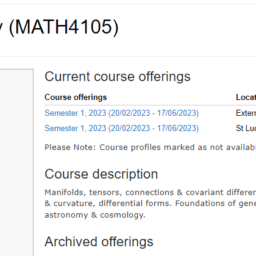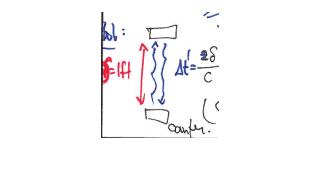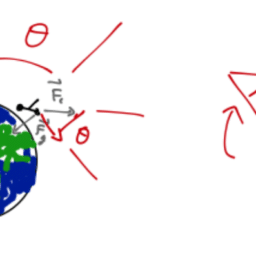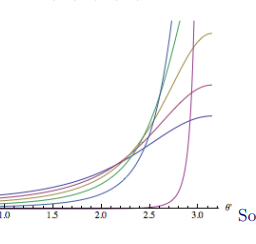MY-ASSIGNMENTEXPERT™可以为您提供my.uq.edu MATH4105 General Relativity广义相对论课程的代写代考和辅导服务!
这是昆士兰大学 广义相对论课程的代写成功案例。

MATH4105课程简介
In his book “Space-Time Structure,” Schrodinger says: “In Einstein’s theory of gravitation, matter and its dynamical interaction are based on the notion of an intrinsic geometric structure of the space-time continuum. The ideal aspiration, the ultimate aim, of the theory is not more and not less than this: A four-dimensional continuum endowed with a certain intrinsic geometrical structure, a structure that is subject to certain inherent purely geometrical laws, is to be an adequate model or picture of the ‘real world around us in space and time’ with all that it contains and including its total behaviour, the display of all events going on in it.”
Acceptance of this notion of “geometrizing” all of physics has waxed and waned since Einstein’s and Schrodinger’s time, but the striking achievements of Einstein’s ‘General Theory of relativity’ compel us to study both the theory and the mathematical structure upon which it is founded.
Prerequisites
Accordingly, the first half of the course will introduce the basic mathematical ideas of pseudo-Riemannian geometry: manifolds; tensors; connections; parallel transport; covariant differentiation; geodesics; curvature; differential forms; Bianchi identities; Ricci, Einstein and Weyl tensors.
By working through problems, the student will have the opportunity to acquire a basic working knowledge of these concepts, and should then have the background necessary for the second half of the course.
MATH4105 General Relativity HELP(EXAM HELP, ONLINE TUTOR)
Show that
$$
\epsilon_{l m n} R_{l i} R_{m j} R_{n k}=\operatorname{det} R \epsilon_{i j k}
$$
for any $3 \times 3$ matrix $R$.
(Recall that the determinant is a scalar function of square matrices which is odd under interchange of rows and columns and has $\operatorname{det} \mathbb{1}=1$. And $\epsilon_{i j k}$ is the completely antisymmetric collection of numbers with $\epsilon_{123}=1$.)
Since $\epsilon$ is completely antisymmetric, this is only one independent equation, which we may take to be $i j k=123$ :
$$
\epsilon_{l m n} R_{l 1} R_{m 2} R_{n 3}=\operatorname{det} R \epsilon_{123}=\operatorname{det} R \text {. }
$$
This is often taken as the definition of the det. In terms of the definition in terms of minors, the RHS is
$$
\begin{aligned}
& \operatorname{det} R=R_{11}\left(R_{22} R_{33}-R_{23} R_{32}\right)-R_{12}\left(R_{21} R_{33}-R_{31} R_{23}\right)+R_{13}\left(R_{21} R_{32}-R_{22} R_{31}\right) \
& =\sum_{i j k} R_{i 1} R_{j 2} R_{k 3}\left{\begin{array}{l}
+1 \text { if } i j k \text { is an even perm. of } 123 \
-1 \text { if } i j k \text { is an odd perm. of } 123
\end{array}\right. \
& =\epsilon_{i j k} R_{i 1} R_{m 2} R_{n 3} \
&
\end{aligned}
$$
This sort of unpacking is a good exercise but gets tedious in higher dimensions. It’s useful to notice that given (1), and summing over the $3 !=6$ nonzero terms, the requested equation is equivalent to
$$
\frac{1}{3 !} \epsilon_{l m n} \epsilon i j k R_{l i} R_{m j} R_{n k}=\operatorname{det} R .
$$
The LHS of this equation satisfies all of the defining properties of the determinant.
Show that the Maxwell equations (in Minkowski space)
$$
\begin{gathered}
\epsilon_{i j k} \partial_j E_k+\frac{1}{c} \partial_t B_i=0, \quad \partial_i H_i=0 \
\epsilon_{i j k} \partial_j B_k-\frac{1}{c} \partial_t E_i=\frac{4 \pi}{c} J_i, \quad \partial_i E_i=4 \pi \rho .
\end{gathered}
$$
are invariant under the following set of transformations:
$$
x^i \mapsto \tilde{x}^i \equiv R_{i j} x^j, \quad R \in O(3)
$$
$$
\begin{aligned}
E_i(x) & \mapsto \tilde{E}i(\tilde{x})=R{i j} E_j(x) \
B_i(x) & \mapsto \tilde{B}i(\tilde{x})=\operatorname{det} R R{i j} B_j(x) \
\rho(x) & \mapsto \tilde{\rho}(\tilde{x})=\rho(x), \quad J_i(x) \mapsto \tilde{J}i(\tilde{x})=R{i j} J_j(x) .
\end{aligned}
$$
That is, $\vec{E}$ is a polar vector and $\vec{B}$ is an axial vector. Recall that an $O(3)$ matrix satisfies $R^T R=\mathbb{1}$.
Under the given transformation, the chain rule implies that
$$
\frac{\partial}{\partial x^i} \mapsto \frac{\partial}{\partial \tilde{x}^i}=\left(R^{-1}\right){j i} \partial_j=R{i j} \partial_j
$$
The LHS of Faraday maps according to
$$
\epsilon_{i j k} \partial_j E_k+\frac{1}{c} \partial_t B_i \mapsto \epsilon_{i j k} R_{j l} \partial_l R_{k m} E_m+\frac{1}{c} \partial_t R_{i j} B_j \operatorname{det} R
$$
Multiply the BHS by $R_{\text {in }}$ (it’s invertible so this is WLOG) to get
$$
\begin{aligned}
0 & =\epsilon_{i j k} R_{i n} R_{j l} \partial_l R_{k m} E_m+\frac{1}{c} \partial_t R_{i n} R_{i j} B_j \operatorname{det} R \
& =\epsilon_{i j k} R_{i n} R_{j l} R_{k m} \partial_l E_m+\frac{1}{c} \partial_t\left(R^T\right){n i} R{i j} B_j \operatorname{det} R \
& =\operatorname{det} R \epsilon_{n l m} \partial_l E_m+\frac{1}{c} \partial_t \delta_{n j} B_j \operatorname{det} R \
\Leftrightarrow \quad 0 & =\epsilon_{n l m} \partial_l E_m+\frac{1}{c} \partial_t B_j
\end{aligned}
$$
(in the second step we used the fact that the rotation matrices are constant in space, and in the third step we used the result of the first problem) which is the original equation. The LHS of Ampere maps according to
$$
\epsilon_{i j k} \partial_j B_k-\frac{1}{c} \partial_t E_i \mapsto \operatorname{det} R \epsilon_{i j k} R_{j l} \partial_l R_{k m} B_m-\frac{1}{c} \partial_t R_{i j} E_j
$$
Now the RHS is a nonzero vector $j_i \mapsto R_i^j j_j$. Again multiply the BHS by $R_{\text {in }}$ to get
$$
\begin{aligned}
\frac{4 \pi}{c} j_n & =\operatorname{det} R \epsilon_{i j k} R_{i n} R_{j l} \partial_l R_{k m} B_m-\frac{1}{c} \partial_t R_{i n} R_{i j} E_j \
& =\operatorname{det} R \epsilon_{i j k} R_{i n} R_{j l} R_{k m} \partial_l B_m-\frac{1}{c} \partial_t\left(R^T\right){n i} R{i j} E_j \
& =(\operatorname{det} R)^2 \epsilon_{n l m} \partial_l E_m-\frac{1}{c} \partial_t \delta_{n j} E_j \
& =\epsilon_{n l m} \partial_l B_m-\frac{1}{c} \partial_t E_j
\end{aligned}
$$
which is the original equation. At the last step we used the fact that $R^T R=\mathbb{1} \Longrightarrow$ $\operatorname{det} R^2=1$. The equations involving the divergence are simpler:
$$
4 \pi \rho=\vec{\partial} \cdot \vec{E} \mapsto 4 \pi \rho=\tilde{\vec{\partial}} \cdot \tilde{\vec{E}}=\partial_k R_{i k} R_{i j} E_j=\partial_k \delta_{k j} E_j=\partial_k E_k
$$
The LHS is a scalar under a rotation (though not a boost). The no-monopoles equation becomes
$$
0=\vec{\partial} \cdot \vec{B} \mapsto 0=\tilde{\vec{\partial}} \cdot \tilde{\vec{E}}=\operatorname{det} R \partial_k R_{i k} R_{i j} B_j=\operatorname{det} R \partial_k \delta_{k j} \tilde{E}_j=\operatorname{det} R \partial_k B_k
$$
The magnetic charge density would have to be a pseudoscalar.

MY-ASSIGNMENTEXPERT™可以为您提供MY.UQ.EDU MATH4105 GENERAL RELATIVITY广义相对论课程的代写代考和辅导服务!





